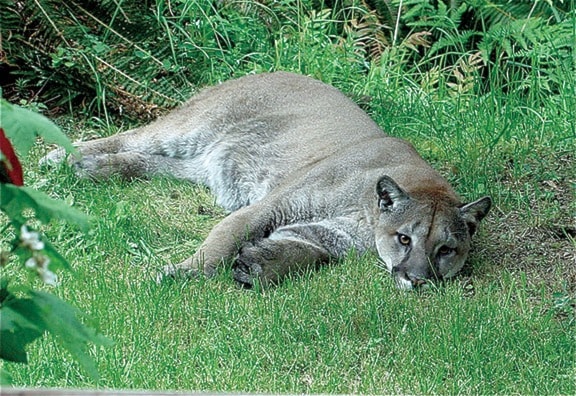Wildlife triggers a variety of emotions from awe and compassion to fear or fascination but certainly respect!
We are approaching the time of year when certain wildlife species are most likely to be spotted; cougars are one, black bears and wolves are other potentially aggressive mammals. Cougars, also known as mountain lions or pumas, are solitary, elusive and mysterious creatures that are often the subject of irrational fears that can result in them being unnecessarily shot.
Cougars are Canada’s largest cat and have sleek muscular bodies and long tails which represent one third of their body length. Adult male cougars can weigh between 140-200 pounds, females range between 90-120 pounds; the largest animals are found in the interior parts of our province. A male cougar needs a large territory often claiming 175 acres as his domain which he will mark with his scent; females tend to remain in areas close to their dens.
The cougar’s habitat includes open areas with nearby rocky outcrops and brushy treed areas where they can hide and stalk their prey. Proficient tree climbers, cougars can jump 20 feet up into a tree from a stationary position, they are also able to jump down to the ground from a 60-foot perch in a tree. Cougars will use trees as vantage points to locate prey or to rest undisturbed. Although cougars prefer to hunt at dawn and dusk, they can be seen roaming around at any time of the day and in any season. During late spring and early summer, conflicts with humans are more likely as the one-to-two-year-old animals become independent and begin searching for a place to establish their own territory.
Often, cougars will leave visible tracks unless the ground is too dry. Like all cats, their claws are retractable and will not show in their footprints (dogs and bears leave clawprints). Cougars are definitely unpredictable, and it is not sure what will trigger an attack from this animal. They do seem to be attracted to small children. Their small size, high-pitched voices and erratic movement might convince the big cat they are prey. Increasing deer populations are being squeezed into a decreasing habitat due to urban expansion, which in turn is attracting cougars into populated areas. Although deer are their main prey they will also eat rabbits, beavers, raccoons and occasionally sheep or other young farm animals.
Each year we remind the public of how to behave if you encounter a cougar, and we are fast approaching the time when sightings are more frequent; there was a recent sighting near the Comox air base. This is due to the available food for them with young mammals straying further from their parents’ protection. The following safety precautions are suggested by Environment Canada:
• Do not walk alone in areas where cougars have been sighted.
• Supervise your children when playing outdoors and inform them what they should do if they encounter a cougar.
• Do not feed deer, raccoons or other prey that may attract a cougar.
• Keep dogs on a leash if walking on trails, and cats inside at night.
What to do if you encounter a cougar: Do not approach the animal and always give it an escape route. Pick up children, back away slowly, and never run or turn your back on the animal: face the cougar. Shout but do not make eye contact; make yourself look larger. People do survive attacks by fighting back.
If you are in the mountains hiking always be aware as cougars are silent, stealthy predators. Always carry a stick and make noise as you walk along the trails. If a cougar shows aggressive behaviour contact the Conservation Service to report the incident at 1-877-952-7277. Enjoy the outdoors for the remainder of the summer and “Be Aware” of wildlife. To report injured wildlife call M.A.R.S. at 250-337-2021.
Sandy Fairfield is the educational co-ordinator for the Mountainaire Avian Rescue Society (MARS). The MARS column appears every second Thursday.
